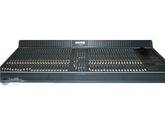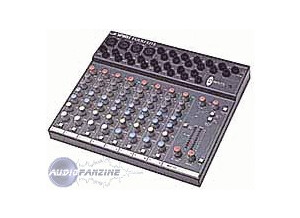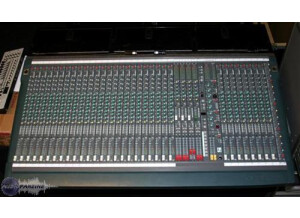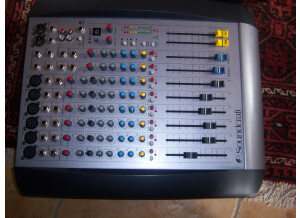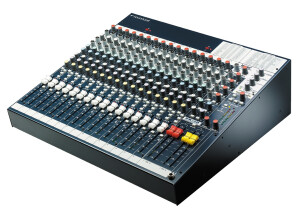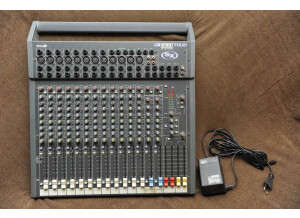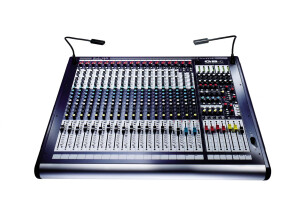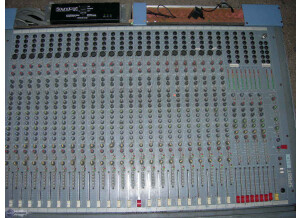Where to buy Sapphyre?
Less
There are no classified ads for this product.
Tech. sheet
- Manufacturer: Soundcraft
- Model: Sapphyre
- Category: Analog Mixers
- Other names:sapphyre
We have no technical specifications for this product
but your help will be much welcomed
»
User reviews
4.0/5(1 reviews)
5
4
100 %
3
2
1
A good choice for small to mid-sized studios
Published on 10/02/17 at 13:57An analog mixer with an in line setup, which allows a direct out to the recorder from each in/out module. However, the mixer features 8 busses, which are repeated in block (1-8, 9-16, 17-24 and so on) all along the mixer and can be used with just any multitrack provided you don’t need more than eight subgroups. Each channel goes into the multitrack’s corresponding track, or to another through the eight subgroups – as for the monitoring it’s done through the track’s corresponding channel, obviously.
This mixer includes – among other things – an input/output module featuring a noise gate, plus a double stereo module, or a double line in module, and all this can be combined in chassis...…
This mixer includes – among other things – an input/output module featuring a noise gate, plus a double stereo module, or a double line in module, and all this can be combined in chassis...…
Read more
An analog mixer with an in line setup, which allows a direct out to the recorder from each in/out module. However, the mixer features 8 busses, which are repeated in block (1-8, 9-16, 17-24 and so on) all along the mixer and can be used with just any multitrack provided you don’t need more than eight subgroups. Each channel goes into the multitrack’s corresponding track, or to another through the eight subgroups – as for the monitoring it’s done through the track’s corresponding channel, obviously.
This mixer includes – among other things – an input/output module featuring a noise gate, plus a double stereo module, or a double line in module, and all this can be combined in chassis featuring 20 to 52 ins. The mixer that I’ve used features 44 inputs. Other features will be developed in the next part.
USE
High quality commutators offer a nice course, but the LEDs are too sparse to my taste and makes getting a global vision difficult: the only LEDs on the in/out module are the Gate On, PFL, mute, solo, peak and active channel indicators.
The faders feel soft and the knobs relatively soft too, they’re larger for more frequent tweaking such as pan setting or monitor level, and nicely color-coded. The color code is also features on the Bounce, Extra Effect and Reverse Fader switches, which are yellow while their send, buss and sub counterparts are in a pale shade of purple. Using the mixer remains quite simple, now let’s see in details its most important functions.
1 inputs:
Input gain is controlled using a double concentric knob for the line/mic in and multitrack in. The mic in will only work if the line switch is up. Switches are here for phase inversion, and a 100Hz high-pass filter. There’s also a purple knob labelled “sub” (bus to channel) which sends the subgroup affected to the channel to the recorder’s corresponding track, with the channel then working as a subgroup “master” control (ala SSL).
2 the Noise Gate:
Like on every nameworthy studio mixing desks, each in/out module features a noise gate which can easily be assigned to any signal path (or input). Three knobs allow to control a bandpass filter (ranging from 70 Hz to 4kHz), a threshold and a release controls. The release control can be held through a control named… HOLD, so as to work like a sustain control for up to 2se with a release time fixed at 0.1s. A 15dB or 60dB attenuation can also be selected using the Range switch. There is also a Flip switch which allows to start the noise gate from the other signal path in the modult to that where the gate is, like on the Neve VR 60! Hallelujah!
3 the equalizer:
The EQ section is divided into two parts, with a HF+LF part and a HMF+LMF part, each being separately switchable to the whole audio path. The rather subtle HF and LF controls deal with the 12kHz and 60Hz frequency areas, with +/- 15dB. The LF’s asymmetrical curve allows cuts with a radical, steepest slope, while the gain setting’s slope is way softer.
The 600Hz-to-12kHz HMF and 100Hz-to-2kHz bands allow for +/-15dB, unfortunately without a bandwith setting, resulting in a gain on a larger band and a cut on a narrower band. There’s a practical reason though, as you’ll often go after suppressing a very specific, localized fault in the sound, while making the sound better generally requires a wider band approach – so as to confere more brightness, for instance.
4 Auxs:
6 aux sends can be found, with the first being a stereo aux. Auxs 1 and 2 can be switched pre- or post-fader, as well as to any audio path. The others are fixed in the monitor path and are of course post-fader only, their main aim being to feed the monitors and studio monitoring effects. This lack of routing can be bore with, even if mutes are still missed to send a vocal (or other) detail to a delay line. Using a Tape Send out through a XFX (Extra Effect) control is possible if need be, like an extra aux send, as this feature attaches the channel’s volume to the monitoring level, which IMHO makes it a source for problems.
5 assignations:
The channel faders come with routing controls, which won’t surprise anyone – not at least thoses used to use a mixer. So, these routing controls go towards the main mixing buss and the eight subgroups that are paired on four switches, through the channel’s pan control. There’s also a bounce switch which bring the recorder’s monitor out back to the mixing busses. There are also XFV and REV Buttons which allow reversing the linear knobs.
Each of the eight busses is placed repeatedly on each 8-channel group, with a “bus” button controlling it. Group 7 goes towards track 7 – or 15 if “buss 7” is set on channel 15 – no trap here. Another button located just under it then allows to listen to the group’s mix on this channel, sending the “Tape Send” signal to the studio monitor buss – nothing unusual here.
6 The master section:
Of course, this section is very simplified compared with big studio consoles. No automation here – not on the model I’ve tested at least. Two big VU-meters can be switched on control either the main mix or the currently selected tracks, which are signalled permanently by two 20-point LEDs above the master section. The six aux general levels have their own “AFL” each, and the aux 1 features a mono switch. A 6-frequency oscillator can be can be routed to the mix or busses. Two keys allow to set the AFL or PFL mode for one, and the SOLO status for the other one – that is interrupting or not the signal’s path in the mixing busses of the whole mixer, with small yet very bright LED indicators! Of course, there are AFL/PFL and overall volume controls, with a “dim” control. Monitoring can be done in mono or through two sets of monitor speakers. Selecting two 2-track recorder controls with the main mix is also possible. These three monitoring sources can be introduced into a “foldback” headphone monitoring buss, which I personally find both clever and practical.
The “foldback” section takes its sound from the main monitor section, and features its own output level, AFL and cut controls.
SOUND
Here we come. First of all and to be totally honest, I must mention that the mixing desk has been entirely refurbished by highly competent people, that I don’t own it andthat it was chosen by a studio wanting to offer a third desk.
Let’s start with the beginning: the preamps are rather good, they only bring little hiss and allow for a great sound dynamics.
The EQ is pleasing and works well, but the combination of both sections don’t make what I’d call a first-class equalizer. Once again, I must mention that I am comparing this Sapphyre with the studio’s other console, an Amek 9098i, and.of course there is little if any ground for comparing – the budget is not the same either. As for the equalizer, it is adequate and efficient but it is not awesome and lacks a bit of subtlety, which is quite surprising at first from a Soundcraft.
OVERALL
This mixer is mostly aimed at a musical use, and i believe this “small” analog console to be a good choice for small to mid-sized studios looking for a worthy analog mixer. This console is quick to get used to and quickly adapts to tracking sessions. For a refurbished 44-input mixing desk, the 11,000 € investment that was made seems to me both reasonable and adequate. It’s a good analog console with great performances, but stripped-down features. Please keep in mind that it’s not an SSL, Neve or Amek, so don’t expect it to be – there’ll be differences and lacks compared with such other models, obviously.
This mixer includes – among other things – an input/output module featuring a noise gate, plus a double stereo module, or a double line in module, and all this can be combined in chassis featuring 20 to 52 ins. The mixer that I’ve used features 44 inputs. Other features will be developed in the next part.
USE
High quality commutators offer a nice course, but the LEDs are too sparse to my taste and makes getting a global vision difficult: the only LEDs on the in/out module are the Gate On, PFL, mute, solo, peak and active channel indicators.
The faders feel soft and the knobs relatively soft too, they’re larger for more frequent tweaking such as pan setting or monitor level, and nicely color-coded. The color code is also features on the Bounce, Extra Effect and Reverse Fader switches, which are yellow while their send, buss and sub counterparts are in a pale shade of purple. Using the mixer remains quite simple, now let’s see in details its most important functions.
1 inputs:
Input gain is controlled using a double concentric knob for the line/mic in and multitrack in. The mic in will only work if the line switch is up. Switches are here for phase inversion, and a 100Hz high-pass filter. There’s also a purple knob labelled “sub” (bus to channel) which sends the subgroup affected to the channel to the recorder’s corresponding track, with the channel then working as a subgroup “master” control (ala SSL).
2 the Noise Gate:
Like on every nameworthy studio mixing desks, each in/out module features a noise gate which can easily be assigned to any signal path (or input). Three knobs allow to control a bandpass filter (ranging from 70 Hz to 4kHz), a threshold and a release controls. The release control can be held through a control named… HOLD, so as to work like a sustain control for up to 2se with a release time fixed at 0.1s. A 15dB or 60dB attenuation can also be selected using the Range switch. There is also a Flip switch which allows to start the noise gate from the other signal path in the modult to that where the gate is, like on the Neve VR 60! Hallelujah!
3 the equalizer:
The EQ section is divided into two parts, with a HF+LF part and a HMF+LMF part, each being separately switchable to the whole audio path. The rather subtle HF and LF controls deal with the 12kHz and 60Hz frequency areas, with +/- 15dB. The LF’s asymmetrical curve allows cuts with a radical, steepest slope, while the gain setting’s slope is way softer.
The 600Hz-to-12kHz HMF and 100Hz-to-2kHz bands allow for +/-15dB, unfortunately without a bandwith setting, resulting in a gain on a larger band and a cut on a narrower band. There’s a practical reason though, as you’ll often go after suppressing a very specific, localized fault in the sound, while making the sound better generally requires a wider band approach – so as to confere more brightness, for instance.
4 Auxs:
6 aux sends can be found, with the first being a stereo aux. Auxs 1 and 2 can be switched pre- or post-fader, as well as to any audio path. The others are fixed in the monitor path and are of course post-fader only, their main aim being to feed the monitors and studio monitoring effects. This lack of routing can be bore with, even if mutes are still missed to send a vocal (or other) detail to a delay line. Using a Tape Send out through a XFX (Extra Effect) control is possible if need be, like an extra aux send, as this feature attaches the channel’s volume to the monitoring level, which IMHO makes it a source for problems.
5 assignations:
The channel faders come with routing controls, which won’t surprise anyone – not at least thoses used to use a mixer. So, these routing controls go towards the main mixing buss and the eight subgroups that are paired on four switches, through the channel’s pan control. There’s also a bounce switch which bring the recorder’s monitor out back to the mixing busses. There are also XFV and REV Buttons which allow reversing the linear knobs.
Each of the eight busses is placed repeatedly on each 8-channel group, with a “bus” button controlling it. Group 7 goes towards track 7 – or 15 if “buss 7” is set on channel 15 – no trap here. Another button located just under it then allows to listen to the group’s mix on this channel, sending the “Tape Send” signal to the studio monitor buss – nothing unusual here.
6 The master section:
Of course, this section is very simplified compared with big studio consoles. No automation here – not on the model I’ve tested at least. Two big VU-meters can be switched on control either the main mix or the currently selected tracks, which are signalled permanently by two 20-point LEDs above the master section. The six aux general levels have their own “AFL” each, and the aux 1 features a mono switch. A 6-frequency oscillator can be can be routed to the mix or busses. Two keys allow to set the AFL or PFL mode for one, and the SOLO status for the other one – that is interrupting or not the signal’s path in the mixing busses of the whole mixer, with small yet very bright LED indicators! Of course, there are AFL/PFL and overall volume controls, with a “dim” control. Monitoring can be done in mono or through two sets of monitor speakers. Selecting two 2-track recorder controls with the main mix is also possible. These three monitoring sources can be introduced into a “foldback” headphone monitoring buss, which I personally find both clever and practical.
The “foldback” section takes its sound from the main monitor section, and features its own output level, AFL and cut controls.
SOUND
Here we come. First of all and to be totally honest, I must mention that the mixing desk has been entirely refurbished by highly competent people, that I don’t own it andthat it was chosen by a studio wanting to offer a third desk.
Let’s start with the beginning: the preamps are rather good, they only bring little hiss and allow for a great sound dynamics.
The EQ is pleasing and works well, but the combination of both sections don’t make what I’d call a first-class equalizer. Once again, I must mention that I am comparing this Sapphyre with the studio’s other console, an Amek 9098i, and.of course there is little if any ground for comparing – the budget is not the same either. As for the equalizer, it is adequate and efficient but it is not awesome and lacks a bit of subtlety, which is quite surprising at first from a Soundcraft.
OVERALL
This mixer is mostly aimed at a musical use, and i believe this “small” analog console to be a good choice for small to mid-sized studios looking for a worthy analog mixer. This console is quick to get used to and quickly adapts to tracking sessions. For a refurbished 44-input mixing desk, the 11,000 € investment that was made seems to me both reasonable and adequate. It’s a good analog console with great performances, but stripped-down features. Please keep in mind that it’s not an SSL, Neve or Amek, so don’t expect it to be – there’ll be differences and lacks compared with such other models, obviously.
See less
00
»
Manuals and other files
Other Soundcraft analog Mixers
Other categories in Mixing Consoles
Where to buy Sapphyre?
Less
There are no classified ads for this product.










